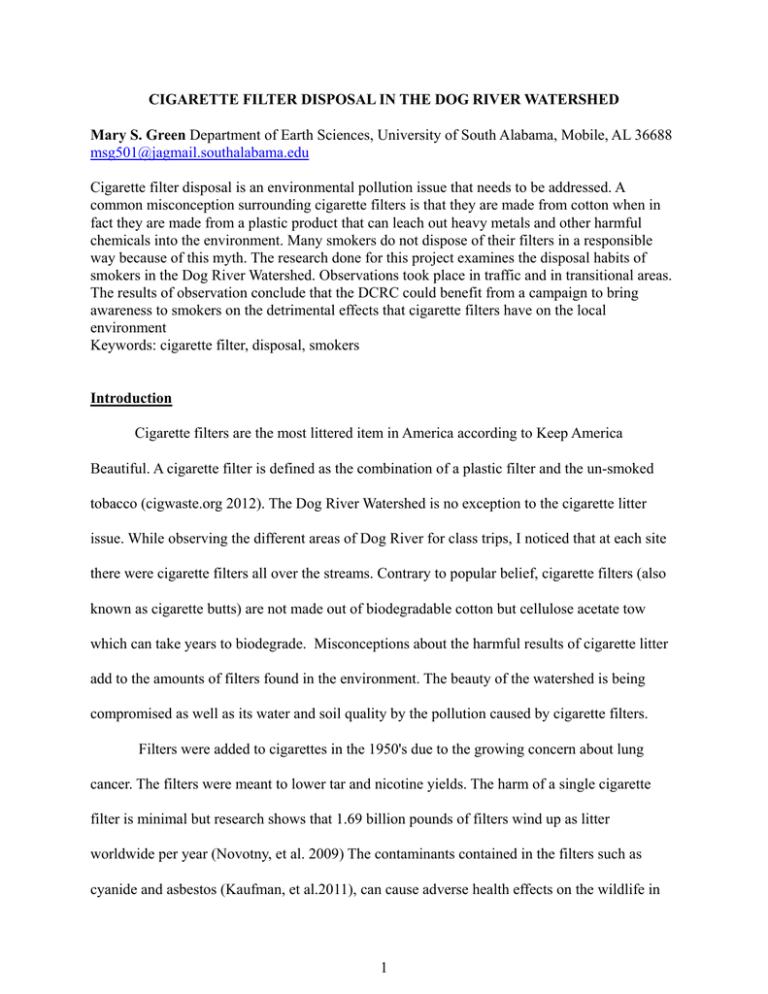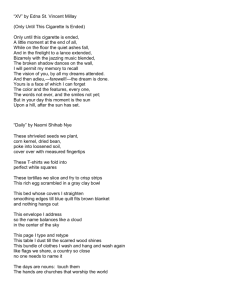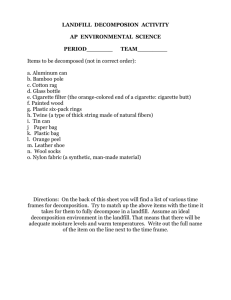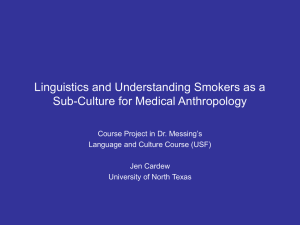Cigarette filter disposal is an environmental pollution issue that needs... common misconception surrounding cigarette filters is that they are made... CIGARETTE FILTER DISPOSAL IN THE DOG RIVER WATERSHED
advertisement

CIGARETTE FILTER DISPOSAL IN THE DOG RIVER WATERSHED Mary S. Green Department of Earth Sciences, University of South Alabama, Mobile, AL 36688 msg501@jagmail.southalabama.edu Cigarette filter disposal is an environmental pollution issue that needs to be addressed. A common misconception surrounding cigarette filters is that they are made from cotton when in fact they are made from a plastic product that can leach out heavy metals and other harmful chemicals into the environment. Many smokers do not dispose of their filters in a responsible way because of this myth. The research done for this project examines the disposal habits of smokers in the Dog River Watershed. Observations took place in traffic and in transitional areas. The results of observation conclude that the DCRC could benefit from a campaign to bring awareness to smokers on the detrimental effects that cigarette filters have on the local environment Keywords: cigarette filter, disposal, smokers Introduction Cigarette filters are the most littered item in America according to Keep America Beautiful. A cigarette filter is defined as the combination of a plastic filter and the un-smoked tobacco (cigwaste.org 2012). The Dog River Watershed is no exception to the cigarette litter issue. While observing the different areas of Dog River for class trips, I noticed that at each site there were cigarette filters all over the streams. Contrary to popular belief, cigarette filters (also known as cigarette butts) are not made out of biodegradable cotton but cellulose acetate tow which can take years to biodegrade. Misconceptions about the harmful results of cigarette litter add to the amounts of filters found in the environment. The beauty of the watershed is being compromised as well as its water and soil quality by the pollution caused by cigarette filters. Filters were added to cigarettes in the 1950's due to the growing concern about lung cancer. The filters were meant to lower tar and nicotine yields. The harm of a single cigarette filter is minimal but research shows that 1.69 billion pounds of filters wind up as litter worldwide per year (Novotny, et al. 2009) The contaminants contained in the filters such as cyanide and asbestos (Kaufman, et al.2011), can cause adverse health effects on the wildlife in 1 the Dog River Watershed. While cyanide is produced naturally in the environment, the additional input of cyanide into an ecosystem can cause developmental defects in fish, the inability to swim or reproduce and can cause respiratory failure in birds (ICMI.com). In addition to these contaminants, heavy metals also leach out of the filters. Heavy metals such as cadmium, chromium and lead are all found in smoked cigarette filters (Moerman, et al. 2011). Lead poisons the nervous system, leading to slower nervous response rates in humans and animals. Cadmium accumulates in the kidneys and causes protein build up as a result of metabolic processes. Cadmium is most lethal to fungi in the soil, leading to slower decomposition due to the elimination of key fungi. Chromium is a leading carcinogen to humans and animals, especially in the high levels that plants and microorganisms can store this heavy metal. Photosynthesis and other metabolic processes are inhibited with chromium poisoning (European Commission 2002). Quantifiable amounts of these dangerous substances were found to have leached out of cigarette filters after one day, while the longer the filter remains in the environment, the greater the contamination. Rapid release of these metals may have acute biological effects on the soil, microorganisms, plants, animals, and humans (Moerman, et al. 2011). By understanding the source of cigarette filter litter and how it effects the environment, the DRCR could build a campaign to promote awareness of responsible cigarette filter disposal. Research Question How can cigarette filter pollution be addressed in the Dog River Watershed? Where do the majority of cigarette filters come from? How can environmental concerns be raised about the amount of toxic cigarette filters in the Watershed? By observing the habits of smokers and researching successful anti-cigarette litter campaigns, I will assist DRCR in creating a program to educate the citizens of the watershed about proper disposal of cigarette filters. 2 Methods My methods for this project included field work to observe smokers’ habits and research on successful anti-litter campaigns specific to cigarette filter litter. I divided my field work up into 2 categories: road disposal and pedestrian disposal. For the road disposal field work, I went to intersections at Airport and Schillinger road(C), Cottage Hill and Hillcrest(B), and Airport and Dauphin Island Parkway (A)(Figure 1). For each of these intersections I took tallies of the smokers who disposed of their filter on the street or disposed of them in their car. For the pedestrian areas, I chose Bel-Air Mall(1), Wynnsong Movie Theaters(2), and Carpe Diem Café(3)(Figure 1). At Bel-Air mall, I observed the front entrance with the most traffic and the loading docks in the back where the mall employees take their breaks. I took tallies on those smokers who disposed of their used filters in receptacles or on the ground. At Wynnsong Theater, I parked in the parking lot in a position to observe the whole front entrance and again took tallies on those smokers who disposed of their cigarettes on the ground or in receptacles. At Carpe Diem coffee shop I observed smokers and took tallies of those who disposed of their used filters on the ground or in receptacles. I did extensive research on Keep America Beautiful anti-cigarette filter litter campaigns and media tools to educate the public. Figure 1. Map of Dog River watershed showing study sites. 3 Results The results I found in each category of pedestrian and traffic disposal showed that when abundant and easy to see designated cigarette litter receptacles were available, smokers were more likely to use these instead of tossing them on the ground. For the traffic category, I was not surprised to find that 100% of the smokers I observed disposed of their finished cigarette filters out of their windows onto the road. I had the most difficulty attaining this information. At the Airport and Schillinger intersection, I was only able to gather scant evidence before a beverage container was tossed out of a window at me, followed by someone yelling out of their car. At the Hillcrest and Cottage Hill intersection, I was affronted by a man asking for money. When he became agitated at my refusal, I left. Finally at the Airport and DIP intersection, I gathered a few pieces of evidence but was again confronted by what I believed to be a homeless person. For future research, I would use binoculars to observe people in traffic. If given sufficient funding, I would find that it would be worthwhile to install cameras at window level at busy intersections to gather more information about the cigarette filter disposal habits of smokers in the Dog River Watershed. For the pedestrian category, I had variations at each location. For Bel-Air Mall, there were 2 available cigarette receptacles available at the entrance. Nine of the 21 smokers I observed put their filters out in these receptacles. The rest of the smokers (11 out of 21) disposed of their cigarettes on the ground despite the available receptacles. In the dock entrance at the back of Bel-Air Mall, there was no designated receptacle for cigarette filters. I observed 20 smokers in all. Seventeen of them disposed of their filters on the ground while the remaining 3 used an old soda bottle to dispose of their filters. At Wynnsong Theaters, 11 out of the 14 smokers I observed disposed of their used filter on the ground. I saw 2 smokers use the 4 designated receptacle at the entrance, a receptacle that was not easily seen. One smoker disposed of their filter in a beverage container. At Carpe Diem Coffee shop, there were 6 tables with 5 ashtrays available. 7 out of the 10 smokers I observed used the ashtrays available while the remaining 3 disposed of their used filters on the ground (Figure 2). For the researching of successful anti-cigarette litter campaigns, I utilized much of the Keep America Beautiful website. As a respected environmental care group, they have endless resources for communities to implement to help alleviate the amount of cigarette filter litter. Media resources such as pre-recorded radio PSA's, pocket ashtrays, filter receptacles, and banners are just a few examples of the many different approaches that Keep America Beautiful uses. From what I have observed about the habits Filter Disposal in Transitional Areas of smokers in the Dog Flick It” campaign would serve to educate the public on the harm of cigarette filter litter and encourage Number of filters 20 River Watershed, a “Don't Ground Receptacle 15 10 5 0 Bel‐Air Mall them to find appropriate receptacles for their used Wynnsong Theater Carpe Diem Café Figure 2. How people disposed of their cigarettes at the 3 study sites. filters. 5 Discussion For the results of my research, I feel it is important to discuss the pervading misconceptions about cigarette filters being made of cotton and biodegradable. Research done on littering habits of humans show that an individual’s decision to litter involves conforming to social norms (Robinson 1976). It seems perfectly natural to most smokers, including myself who is a previous smoker to simply toss out the filter when the cigarette is out, completely unaware of the consequences because it is a habit that is observed in other smokers. Being aware of negative consequences causes more consideration in littering of all items. Education of the harm that their litter can cause to the environment will possibly make smokers more responsible for their actions. There are many smokers who consider themselves to be environmentally conscious, taking actions such as recycling and driving electric cars who still do not fully know the extent that their cigarette filters have on local environments. Fears about tossing filters into trash cans and creating fires also pervades the smoker culture. I believe it is important to educate smokers into being more conscious about how they dispose of their cigarette because I don't believe they are irresponsible with the intent of harming the environment, but have been conditioned to believe that their actions are harmless and stay within social norms. By reinforcing an alternative social norm such as taking more consideration into cigarette disposal, there can be huge improvements over the amount of cigarette filter litter in the Dog River Watershed. Conclusion From my observations I conclude that if designated receptacles are convenient to use, that smokers are more likely to responsibly dispose of their filters in pedestrian areas. In traffic, there are few remedies to the disposal on the road other than educating smokers about the harmful environmental effects. Car ashtrays are hard to keep clean and in my experience, they are not 6 even a viable option for cigarette filter disposal. From my research on the “Don't Flick It” campaign there are options such as personal pocket ashtrays but I believe it is not a permanent solution. For pedestrian areas, they are much easier controlled. By placing more labeled containers around, smokers are more likely to use them. Placing banners that have information about the real substances that are found in cigarette filters such as carcinogens and heavy metals could serve to educate smokers about responsibly disposing of their cigarettes. Radio PSA's that tells of the harm to the environment as a result of cigarette filters could also help to educate the public. For DCRC I believe that the most effective tool in reducing the amount of cigarette litter in the Dog River Watershed will be media involvement and encouraging the city of Mobile to enact a waste tax similar to those imposed on electronics to cover costs involved in recycling and disposing of the product. A fee or tax on a pack of cigarettes could be earmarked for DCRC to put towards clean-up efforts and consumer education (Novotny et al. 2009). Banning smoking on beaches and other nature-related areas could also lower the amount of cigarette filter trash as seen in Chicago, Florida, and Hawaii but because of urban run-off there is still filter waste on the beaches. Because of the pervading myth that cigarette filters are biodegradable, there has been little quantifiable research done on the effect of degrading cigarette filters in the environment. From my studies on the leaching of harmful chemicals and heavy metals, there should be cause for sufficient alarm at the detrimental effects that these can have on the environment, especially one as sensitive as the Dog River Watershed. More scientific and chemical research is needed to make final conclusions. 7 References Cited Cigarette Butt Pollution Project [online](2012)[Accessed February 29, 2012] Available from Cigwaste.org “Environmental and Health Effects of Cyanide.” Cyanidecode.org April 18, 2012 “Heavy Metals in Waste.” European Commission. February 2002 Kaufman, Leslie. “Cigarette Butts: Tiny trash that piles up.” San Diego State University. ROHAN Academic Computing web server Kaufman, Martin M., Rogers, Daniel T., Murray, S. Kent. (2011) Urban Watersheds: Geology, Contamination, and Sustainable Development. Boca Raton, FL: CRC Press. Keep America Beautiful.[online](2006)[accessed February 23, 2012] Available from kab.org Moerman, J.W., Potts, G.E. “Analysis of Metals leached from smoked cigarette litter.” Tobacco Control. Vol. 20.1 January 2011 Novotny, T.E., Lum, K., Smith, E., Wang, V., Barnes, R. “Cigarette Butts and the Case for and Environmental Policy on Hazardous Cigarette Waste.” International Journal of Environmental Research and Public Health 2009; Vol 6.5; pp 1691-1705. Robinson, Stuart M., “Littering Behavior in Public Places.” Environment and Behavior 1976 Vol.8.363 8





